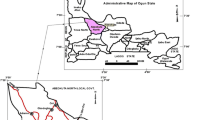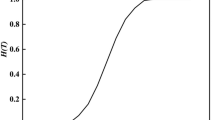Abstract
The objective of this study was to investigate the effects of diurnal temperature fluctuation amplitude (DTFA) on the geothermal regime of the embankment on the Qinghai–Tibet plateau. The investigation was simulated by respectively denoting the diurnal temperatures at the embankment surface, embankment slope, and natural ground surface with sinusoidal waves. The amplitudes of the waves were denoted by 0°C, 5°C, 8°C, and 12°C, respectively. The numerical result shows that the DTFA cannot vary the frequency of the seasonal temperature fluctuation of the underlying soil, but can significantly change the magnitude of the soil’s temperature. The changes include: (1) The high DTFA, such as 12°C, can significantly lead to the warming of the soil under the embankment. (2) Interestingly, when the DTFA at ground surface is 5°C, the underlying soil is in a cooler stage compared to when such DTFA is 0°C, 8°C, or12°C. This interesting result means that the documented model which ignores the diurnal temperature rhythm overestimates the warming of the underlying soil at the low DTFA region and underestimates such warming at the high DTFA region. This result also suggests that the soil under the embankment can be cooled down if the DTFA on the ground surface was maintained at or approximately at 5°C.
ملخص البحث
تم من خلال هذه الدراسة تحري تحري تأثير التغييرات اليومية لدرجة الحرارة على منظومة الحرارة الجوفية لسدة جنغهاي في هضبة التبت. تم متابعة التغييرات الحرارية على سطح السدة, سفح السدة و سطح الارض الطبيعي تحت السدة. تتخذ التغييرات الحرارية اليومية شكل موجة جيب بتباين يمثل الفرق بين قمة وقعر الموجة. تم دراسة فرق درجات الحرارة بمقدار صفر, خمسة, ثمانية , واثني عشر درجة مئوية. التحليل العددي للنتائج اظهر ان التغييرات اليومية لاتؤثر على تواتر التغييرات الموسمية ولكن يمكنها ان تؤثر بدرجة ملحوظة على درجة حرارة التربة. التأثيرات تشمل اولا: التباينات اليومية العالية مثل اثني عشر درجة مئوية يمكنها ان ترفع من درجة الحرارة تحت السدة, ثانيا: من المثير للاهتمام ان تباين درجة حرارة يومي بمقدار 5 درجات مئوية على السطح قد ادى الى درجة حرارة ابرد من تباين صفر , ثمان و اثني عشر درجة مئوية على التربة تحت السدة. هذا يدل على ان النموذج الرياضي الذي يهمل تأثيرات تواترالتغييرات اليومية في درجة الحرارة يبالغ في تقدير التسخين في حالة التباينات اليومية الواطئة في درجة الحرارة ويقلل من تقدير التسخين في حالة التباينات اليومية العالية في درجات الحرارة. يستنتج ايضا من النتائج انه يمكن تبريد التربة تحت السدة اذا تم المحافظة على تباين يومي بمقدار خمس درجات مئوية تقريبا لدرجة الحرارة على السطح.








Similar content being viewed by others
References
Andersland OB, Ladanyi B (1994) An introduction to frozen ground engineering. Chapman & Hall, New York
Armagahni JM, Larsen TJ, Smith LL (1987) Temperature response of concrete pavements. J Trans Res Board 1121:23–33
Cheng G, Sun Z, Niu F (2008) Application of the roadbed cooling approach in Qinghai–Tibet railway engineering. Cold Reg Sci Technol 53(3):241–258
Chenji H, Doushun, Qianzeyu (2006) Yin-Yang Slope problem along Qinghai–Tibetan Lines and its radiation mechanism. Cold Reg Sci Technol 44(3):217–224
French HM (2007) The periglacial environment. Wiley, West Sussex
Li G, Li N, Quan X (2006) The temperature features for different ventilated-duct embankments with adjustable shutters in the Qinghai–Tibet railway. Cold Reg Sci Technol 44(2):99–110
Li G, Li N, Kang J (2007) Heat transfer characteristics of the embankment with crushed-rock slope protection in permafrost regions along the Qinghai–Tibet Railway. Journal of Glaciology and Geocryology 29(2):315–321 (in Chinese)
Li S, Lai Y, Zhang M, Dong Y (2009) Study on long-term stability of Qinghai–Tibet Railway embankment. Cold Reg Sci Technol 57(2–3):139–147
Ma W, Qi J, Wu Q (2008) Analysis of the deformation of embankments on the Qinghai–Tibet Railway. J Geotech Geoenviron Eng 134(11):1645–1654
Qin D (2002) Assessment on the environment in Western China. Science Press, Beijing
Qin Y, Zheng B (2010) The Qinghai–Tibet Railway: a landmark project and its subsequent environmental challenges. Environ, Dev Sustain. doi:10.1007/s10668-009-9228-x
Qin Y, Zhang J, Li G, Qu G (2010) Settlement characteristics of unprotected embankment along the Qinghai–Tibet Railway. Cold Reg Sci Technol 60(1):84–91
Quan X, Li N, Li G (2006) A new ripraped-rock slope for high temperature permafrost regions. Cold Reg Sci Technol 45(1):42–50
Wang B, French HM (1994) Climate controls and high-altitude permafrost, Qinghai–Xizang (Tibet) Plateau, China. Permafrost Periglac Process 5(2):87–100
Ya-ling C, Yu S, Zhen-ming W, Wei M (2008) Calculation of temperature differences between the sunny slopes and the shady slopes along railways in permafrost regions on Qinghai–Tibet Plateau. Cold Reg Sci Technol 53(3):346–354
Ya-ling C, Yu S, Zhen-ming W (2009) Evaluation on thermal stability of embankments with different strikes in permafrost regions. Cold Reg Sci Technol 58(3):151–157
Yu HT, Khazanovich L, Darter MI, Ardani A (1998) Analysis of concrete pavement responses to temperature and wheel loads measured from instrumented slabs. Transportation Research Record: J Trans Res Board 1639:94–101
Yu Q, Pan X, Cheng G, He N (2008) An experimental study on the cooling mechanism of a shading board in permafrost engineering. Cold Reg Sci Technol 53(3):298–304
Zhang J (2007) Estimation on the settlement and deformation of embankment along Qinghai–Tibet Railway in permafrost regions. Hongguo Tiedao Kexue/China Railway. Science 28(3):12–17
Zhang M, Lai Y, Liu Z, Gao Z (2005a) Nonlinear analysis for the cooling effect of Qinghai–Tibetan Railway embankment with different structures in permafrost regions. Cold Reg Sci Technol 42(3):237–249
Zhang M, Zhang J, Lai Y (2005b) Numerical analysis for critical height of railway embankment in permafrost regions of Qinghai–Tibetan Plateau. Cold Reg Sci Technol 41(2):111–120
Zhang T, Baker THW, Cheng G-D, Wu Q (2008) The Qinghai–Tibet Railroad: a milestone project and its environmental impact. Cold Reg Sci Technol 53(3):229–240
Zheng B, Zhang J, Qin Y (2010) Investigation for the deformation of embankment underlain by warm and ice-rich permafrost. Cold Reg Sci Technol 60(2):161–168
Author information
Authors and Affiliations
Corresponding author
Rights and permissions
About this article
Cite this article
Qin, Y., Tang, P. Effects of diurnal temperature rhythm on the geothermal regime under the embankment in Qinghai–Tibet plateau. Arab J Geosci 4, 259–267 (2011). https://doi.org/10.1007/s12517-010-0166-6
Received:
Accepted:
Published:
Issue Date:
DOI: https://doi.org/10.1007/s12517-010-0166-6




